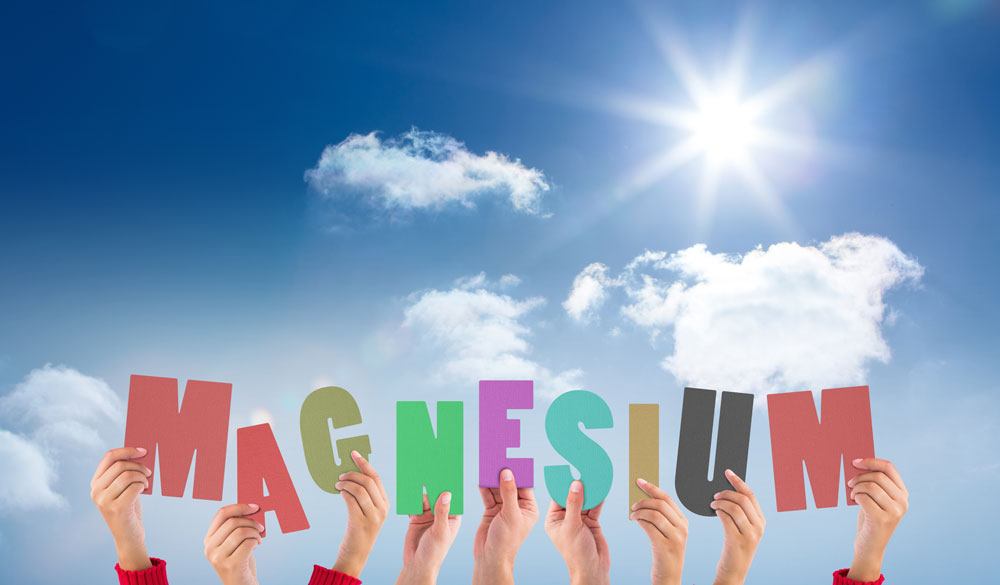What is the most common elemental deficiency in my practice? Magnesium. This is probably the most underutilized “medicine” out there for restless legs, constipation, kidney stones, leg cramps, menstrual cramps, asthma and many other medical conditions including treatment resistant depression. It has tons of research available to support its use in these and many other medical conditions but often it is overlooked because I personally feel we as doctors have not been educated on its benefits except for “emergency” cases. It is not a drug so there are no people sitting in tubs on a cliff holding hands and talking about its benefits on TV and there is no Magnesium Lobby group to push its cause so I will try to champion the miracle mineral here.
Magnesium is the most utilized mineral in the body and is responsible for actions ranging from relaxation and decalcification of the arteries to utilizing sugar in the cell all the way to improving mood. We cannot survive without it. In my practice it plays an essential role. After first addressing inflammation in the gut(see my post on gluten sensitivity) I then address magnesium status as the second step in almost all treatment plans especially for those patients with depression and anxiety. Matter of fact, this mineral is essential for relaxation and mood. Magnesium is better than the anti depressants in studies with postpartum depression and treatment resistant depression. Interestingly, treatment resistant depression is not a Zoloft deficiency to start with but more likely is a magnesium deficiency. Treatment resistant depression is largely due to magnesium deficiency and there is quite a bit of data to back this up. By adding magnesium to their current regimens almost 80 percent had resolution of their symptoms of depression.
Not only good for mood disorders, it also has amazing effects on the brain in general. Magnesium repairs the brain following stroke. One study showed a 50% improvement on mental functioning with administering magnesium one year after the stroke! Another brain issue is migraines and you guessed it, magnesium is an effective cure. It is always my first and most effective intervention for migraine. “Wow, magnesium is awesome” you say,” and I will have my doctor check my levels right away.” As the sports announcer Lee Corsco says “Not so fast my friend…”
It is hard to measure total body stores since 99% is in the tissues and only 1% is in the blood, where our testing is performed. We can be depleted of magnesium in our body compartments but our blood shows we are normal which is only 1% of our total stores. We will use that 99% to keep the 1% in the normal range and our brain tissue may be very low and our blood levels be normal. So what to do? Assume you are magnesium deficient as most of us are (over 80%) and this can be explained by our diet and exposures.
Back in the days of clubbing our women over their head and dragging them back to our cave (not cool now except in Arkansas where this is still very vogue)*, we had a lot more magnesium in our diet. In fact, the ratio of magnesium to calcium was 1:1. It is now near 1:6. This ratio has worsened with the introduction of row crop farming on a large scale. We have mineral depleted soil and it has very little organic matter so the food we grow in it is less than complete in nutrition. One of the major minerals we are missing in our processed food is magnesium. We are also wasting it with stress, caffeine intake and not able to replace it with our processed food. Another unseen cause of depletion of magnesium is ironically diuretic meds (hydrochlorothiazide is one of the most common) used to treat high blood pressure which causes long term magnesium depletion which causes high blood pressure. We doctors be jeanusisses. So long story short-we are a generally magnesium depleted society and we need to get some now at some “Superstore.” Once again, not so fast my friend.
Ok, so I’ve got nothing against a certain conglomerate chain of stores where you can buy anything except maybe crack pipes, (except the way it treats its employees and runs small business out of business so maybe I do), but in regards to magnesium, this is not your best source to buy it. Magnesium comes in a lot of different forms and if you want to actually absorb it you will need the right kind. Your doctor’s office (nutritional oriented doctors office that is) or higher end health food store or specialty pharmacy is the place to start. Magnesium Taurate is probably my favorite but is the hardest to find. The taurate portion of the magnesium chelate is very calming to the brain and works in synergy with magnesium to help with mood. My next favorite is Magnesium Glycinate and is a little easier to find and is cheaper than Taurate. It does little to create GI upset like Mag Oxide and is very effective in higher doses without side effects of diarrhea. Next, there is Magnesium Citrate which is good for constipation and but still allows absorption of magnesium, unlike Mag Oxide, but can cause loose stools in high doses. Magnesium citrate is cheaper than the previously mentioned magnesium chelates and overall is good all around magnesium. Finally, there is magnesium oxide which is what the cheaper magnesium brands are made of. You get a lot of concentrated magnesium in one pill but only absorb about 4% of it. This should only be really used for constipation and not replacement. If cheap is more important than whether it works effectively, then you should choose this one (see you at the crapper). When choosing your magnesium be careful is not combined with mag oxide which is used to decrease costs and lessens the efficacy of the good magnesium.
Another way to get magnesium is topically with magnesium chloride oil or Epsom salts baths. Topical magnesium replaces magnesium faster than if taken by mouth and gets body back to normal levels in 1-2 months instead of 6-12 months like oral magnesium does. ” Oh wow, you mean I have to keep taking pills for more than one day”. Yes, and you have to take quite a few pills a day for many months to get where you need to be in total body load if you are depleted.
Now we have the kinds of magnesium, although the above is not a complete list, how much should we take? The best way to go is to start by taking Epsom Salt baths-2 cups in hot tub x 30 mins. This is cheap and you can get at any store.
Topical magnesium oil is easily found at health food stores and can be applied daily or twice a day. The chelated magnesiums (taurate, glycinate, and citrate) are usually in 100-150 mg per capsule dosages so I recommend 600-900 mg a day and if you can tolerate it you can go even higher (loose stool is a tip off you need to back down a pill or two). The obvious question is whether you can take too much? The answer, not really, unless you have chronic kidney disease then would go with much smaller doses and you would want to be monitored by a physician. If you do not have kidney disease you will be able to excrete any excess magnesium in urine or your stool. Other instances where you would want to be careful is excessively slow heart rate (works to slow down heart which is usually good and works well for atrial fibrillation), myasthenia gravis, or bowel obstruction (can’t eliminate excess).
Long article made even longer, magnesium is the first place to start for depression. It is a long undervalued mineral missing in our diet due to years of depletion in our soil. It is easily replaced inexpensively. Magnesium does a body good.
* Being from Louisiana it is my job to make fun of Arkansas, so if anyone there is reading this please know I am proud of you for reading this.
(Disclaimer-I am looking to start a Magnesium Lobby Group-so send money)
Dr. Nathan Morris, MD





